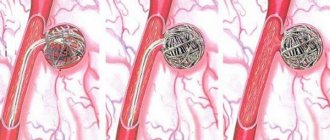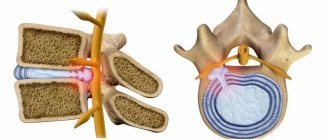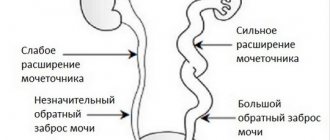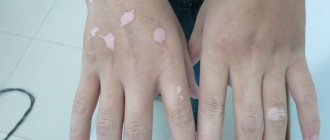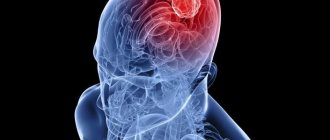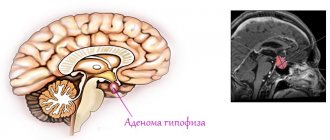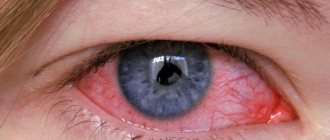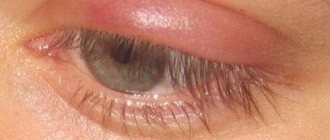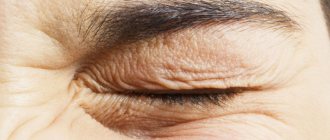Polio
- a viral infection that primarily affects the central nervous system (gray matter of the spinal cord) and leads to the development of flaccid paresis and paralysis. Depending on the clinical form, the course of poliomyelitis can be either asymptomatic (with short-term fever, catarrhal symptoms, dyspepsia), or with severe meningeal symptoms, vegetative disorders, development of peripheral paralysis, limb deformities, etc. Diagnosis of poliomyelitis is based on the isolation of the virus in biological fluids, results of RSK and ELISA diagnostics. Treatment of polio includes symptomatic therapy, vitamin therapy, physiotherapy, exercise therapy and massage.
General information
Poliomyelitis (Heine-Medhin disease, infantile spinal palsy) is an enteroviral infection caused by polioviruses that infect the motor neurons of the anterior horns of the spinal cord, which leads to severe paralytic complications with disability of the patient. The greatest susceptibility to polio (60-80%) is observed in children under the age of 4 years, so the disease is studied mainly in pediatrics, child neurology and pediatric orthopedics.
The last polio epidemic in Europe and North America was recorded in the middle of the last century. In 1988, WHO adopted a resolution proclaiming the goal of eradicating polio from the world. Currently, in countries where preventive vaccination against polio is carried out, the disease occurs in the form of isolated, sporadic cases. Afghanistan, Nigeria, Pakistan, Syria, and India are still endemic for polio. Countries in Western Europe, North America and Russia are considered polio-free areas.
Historical information and interesting facts
Expert opinion
CM. Harit
Professor, Doctor of Medical Sciences, Head of the Department of Prevention of Infectious Diseases of the Research Institute of Children's Infections
In Europe and the USA and Japan and Australia and other countries, vaccinations are given with a killed polio vaccine, in our country the child receives the first 2 vaccinations with the same killed vaccine and only the subsequent ones with a live one...
Scientific research on polio dates back to the work of the German orthopedist J. Heine (1840), the Russian neurologist A. Ya. Kozhevnikov (1883) and the Swedish pediatrician O. Medina (1890), who showed the independence and contagiousness of this disease.
Iron Lung apparatus, circa 1950
Before the polio vaccine was invented, patients were placed in an iron lung machine that stimulated breathing. It was he who served as the prototype of modern anesthesia machines and devices for artificial ventilation of the lungs.
On April 112, 1955, a large-scale study was successfully completed in the United States, confirming the effectiveness of the Jonas Salk vaccine, the first vaccine against polio. The importance of this event cannot be overestimated. In 1954, more than 38 thousand cases of polio were reported in the United States, and after 10 years of the use of the Salk vaccine, in 1965, the number of cases of polio in the United States was only 61.
All over the world, attenuated (weakened) strains obtained by Dr. Sabin - serotypes 1, 2 and 3 - are used for the production of live polio vaccines.
3 serotypes. No indigenous wild poliovirus type 2 has been detected in the world since 1999. 26-31% of VAPP cases are associated with vaccine virus 2, which is a component of trivalent OPV. It has therefore become critical to move from the use of trivalent OPV (containing virus serotypes 1,2 and 3) to bivalent OPV (containing only serotypes 1 and 3) in national immunization programs and to coordinate this transition internationally. In 2020, the World Health Assembly agreed that all WHO Member States currently using OPV should prepare for a global phaseout of the type 2 poliovirus component of OPV. In April 2020, all stocks of trivalent OPV were seized and destroyed from all service delivery points, and their seizure was confirmed by WHO.
Causes of polio
The infection is caused by three antigenic types of poliovirus (I, II and III), belonging to the genus Enterovirus, family Picornavirus. The greatest danger is the polio virus type I, which causes 85% of all cases of the paralytic form of the disease. Being stable in the external environment, the polio virus can survive up to 100 days in water and up to 6 months in feces; tolerate drying and freezing well; is not inactivated by digestive juices and antibiotics. The death of poliovirus occurs when heated and boiled, ultraviolet irradiation, and treatment with disinfectants (bleach, chloramine, formaldehyde).
The source of infection for polio can be either a sick person or an asymptomatic virus carrier who secretes the virus in nasopharyngeal mucus and feces. Transmission of the disease can be carried out by contact, airborne droplets and fecal-oral routes. Susceptibility to the polio virus in the population is 0.2–1%; The vast majority of cases are children under 7 years of age. Seasonal peaks of incidence occur in the summer-autumn period.
Vaccine-associated poliomyelitis develops in children with severe congenital or acquired immunodeficiency (usually HIV infection) who received a live oral attenuated vaccine.
Conditions conducive to the spread of the polio virus are insufficient hygiene skills in children, poor sanitary and hygienic conditions, overcrowding of the population, and the lack of mass specific prevention.
The entry gate for the polio virus in the body of a new host is the lymphoepithelial tissue of the oropharynx, nasopharynx, and intestines, where the primary replication of the pathogen occurs and from where it penetrates into the blood. In most cases, primary viremia lasts 5-7 days and, when the immune system is activated, ends in recovery. Only 1-5% of infected people develop secondary viremia with selective damage to motor neurons in the anterior horns of the spinal cord and brain stem. Penetration of the polio virus into nervous tissue occurs not only through the blood-brain barrier, but also through the perineural route.
Invading cells, the polio virus causes a disruption in the synthesis of nucleic acids and proteins, leading to dystrophic and destructive changes up to the complete death of the neuron. The destruction of 1/3-1/4 nerve cells leads to the development of paresis and complete paralysis, followed by muscle atrophy and contractures.
general information
Childhood polio is much more common than adult polio. The virus often affects children under ten years of age, causing them to be developmentally delayed and their limbs to be severely deformed.
Heine-Medina disease in most cases occurs in a latent form, without causing severe neurological disorders. Clinical signs are typical for one percent of all infected people. The disease is detected 2-3 weeks after its onset. The probability of death is quite low, and paralysis of the respiratory center leads to it.
The disease began to be studied in 1840, and the first effective vaccine was developed in the 1950s. Due to several outbreaks of the disease in the 20th century, WHO launched a program to vaccinate the population. Since then, the risk of infection has decreased by 99%. And regions such as Europe, America and the Western Pacific are considered virus-eradicated zones.
Source of the disease
Enterovirus is a spherical virus that belongs to the family Picovrnaviridae. Its dimensions vary from 27 to 30 nm. It is he who causes the disease. Its structure is a chain of RNA molecules that carry data about the pathogen, enclosed in a protein shell. The virus contains no fat, which makes it resistant to acidic environments and the influence of solvents.
The activity of the polio virus in the external environment is about 3 months in water, and up to six months in feces. The infectious properties at low temperatures remain for quite a long time, and when boiled, under ultraviolet light and under the influence of disinfectants, the virus quickly dies.
The structure of the protein shell differs; on this basis, three strains (I, II, III) of the virus were isolated. When vaccinated and infected, the body develops immunity, which provides lifelong protection against re-infection. But such an immune response cannot protect against other strains of polio, so it is not ideal. Often, infection with the first type of virus leads to complications of a paralytic nature.
Only humans are the carrier of the virus; sometimes primates are also infected, but they cannot be the source of infection.
Poliovirus affects the gastrointestinal tract; after penetration into the mucous membranes of the tract, it, using the structural cells of the body, begins to multiply en masse. When the virus collects the required number of viral particles, the pathogen will begin to spread, affecting the intestinal lymphoid tissue.
Viremia (entry of the virus into the blood) begins 3-4 days after infection. Usually during this period the body produces antibodies that effectively destroy it, so the disease begins to develop in an asymptomatic form. But sometimes, with massive viremia, the disease takes on a more severe form, in which the virus penetrates the tissues of the brain and spinal cord. The mechanism of infection of the central nervous system has not yet been elucidated. According to medical scientists, the virus is carried by the bloodstream from muscle nerve endings to the brain.
Poliovirus remains in brain tissue for several days. After this time, it is impossible to detect it, but despite this, the inflammation process does not stop and can last 2-3 months, infecting more and more motor and autonomic neurons.
Causes of polio
You can become infected not only from a sick person. Due to the fact that the virus is resistant to external factors, it can enter the body in other ways.
There is a concept of the mechanism and methods of transmission of infection. The mechanism is understood as the way in which the pathogen, from the beginning of its release into the environment, moves into the susceptible human body. The poliomyelitis virus has a fecal-oral transmission mechanism. This means that a sick person releases the pathogen into the external environment along with urine, vomit and feces.
And the path is the factor that ensures the interaction of the virus with the point of entry into the body of the infected person.
There are three routes of transmission of polio:
- In terms of epidemiology, the most important is the food route . In this case, the infection is transmitted by contamination of food products with infected particles if sanitary control and hygiene rules are not observed.
- The water route is rarely identified and involves the consumption of contaminated water. But if there is a large release of wastewater and sewage into water sources, this route may well become a source of infection.
- Household means infection through contact with household objects that contain virus particles. This route of transmission is not dangerous in itself. If you follow the rules of personal hygiene, the virus from your hands will not be able to get into the environment suitable for it - the oral mucous membranes.
Sometimes an aerosol route of transmission is identified - infection by particles that the patient releases when coughing, talking or sneezing. But this path can cause harm only at the initial stage of the disease and only with very close contact.
Susceptibility and risk factors
The susceptibility of an organism is its ability to react to any foreign invasion. Human natural susceptibility to polio is very high. Often, a person simply becomes a carrier of the virus without showing clinical or pathological symptoms. Symptoms manifest themselves very rarely, and the paralytic picture is observed in 1-10 cases out of 1000.
There are a number of factors that can aggravate the course of the disease. Among them are the following:
- Floor. The risk of infection is the same for both sexes until puberty. With age, females aged 18-25 years without immunity are more at risk of infection. PPS (myelitis) is also observed more often in women.
- Age. Children and adolescents are mainly susceptible to the disease, since their bodies are most susceptible to infectious pathogens, and they come into more contact with contaminated materials.
- Pregnancy period. A woman’s body during such a period is very susceptible to infection.
- Recent tonsil removal may cause damage to the brain stem.
- According to research, the paralytic form of the disease often affects the limb that received intramuscular injections shortly before infection.
Live weakened virus
There are two types of vaccination. The first uses a live, attenuated virus. The vaccine has advantages compared to using an inactivated virus. But there are cases that it becomes the cause of the development of the disease. That is why a number of countries do not use it. It is worth considering that the paralytic form of polio caused by vaccination is so small that the probability of developing the disease is 1 case in 2.6 million vaccinated people.
The live virus is introduced into the body through the mouth. Due to this, it follows a natural path and is capable of inducing the synthesis of not only blood antibodies, but also secretory ones, which protect against re-infection through the gastrointestinal mucosa.
After receiving the first dose of the vaccine, the disease develops within 7-14 days. Often, the occurrence of polio is associated with immunodeficiency of the person who was vaccinated.
Classification of polio
In clinical practice, there are forms of poliomyelitis that occur without damage to the nervous system and with damage to the central nervous system. The first group includes inapparant and abortive (visceral) forms; the second - non-paralytic (meningeal) and paralytic forms of polio.
Depending on the level of damage to the nervous system, the paralytic form of poliomyelitis can be expressed in the following variants:
- spinal
, which is characterized by flaccid paralysis of the limbs, neck, diaphragm, torso; - bulbar
, accompanied by speech disorders (dysarthria, dysphonia), swallowing, cardiac activity, breathing; - pontine
, occurring with complete or partial loss of facial expressions, lagophthalmos, drooping corner of the mouth on one half of the face; - encephalitic
with cerebral and focal symptoms; - mixed
(bulbospinal, pontospinal, bulbopontospinal).
A post-vaccination complication such as vaccine-associated paralytic poliomyelitis is considered separately. The incidence of paralytic and non-paralytic forms of polio is 1:200.
During paralytic forms of polio, incubation, preparalytic, paralytic, recovery and residual periods are distinguished.
Vaccines
There are two types of vaccines to prevent polio—live oral polio vaccine (OPV) and inactivated polio vaccine (IPV). OPV provides essential protection for children against polio. If used repeatedly, it protects the child for life. All available evidence indicates that OPV is not teratogenic and is safe for pregnant women and HIV-infected individuals. However, rare serious adverse events associated with OPV may include vaccine-associated paralytic polio (VAPP) among vaccinated individuals and their contacts, and the emergence of vaccine-derived polioviruses (VDPV). The incidence of VAPP is estimated to be 2–4 cases per million births per year in countries using OPV. The introduction of at least one dose of IPV before OPV vaccination leads to the elimination of VAPP. Let us remind you that in the National Calendar of Preventive Vaccinations of the Russian Federation, the first two (!) vaccinations against polio are given with inactivated polio vaccine!
IPV is considered a highly safe vaccine whether given alone or in combination with other vaccines. There is no evidence of a cause-and-effect relationship with adverse events other than mild local erythema (0.5-1%), tissue induration (3-11%), and tenderness (14-29%).
More about vaccines
Symptoms of polio
The incubation period for various forms of polio averages 8–12 days.
Inapparate form
Poliomyelitis is a carriage of the virus, which does not manifest itself clinically and can only be detected in the laboratory.
Abortive (visceral) form
polio accounts for more than 80% of all cases of the disease. Clinical manifestations are nonspecific; Among them, general infectious symptoms predominate - fever, intoxication, headache, moderate catarrhal symptoms, abdominal pain, diarrhea. The disease ends after 3-7 days with complete recovery; no residual neurological symptoms are noted.
Meningeal form
Poliomyelitis occurs as benign serous meningitis. In this case, two-wave fever, headaches, and moderately severe meningeal symptoms (Brudzinsky, Kernig, stiff neck) are noted. After 3-4 weeks recovery occurs.
Paralytic form
Poliomyelitis has the most severe course and outcomes. In the preparalytic period, general infectious symptoms predominate: fever, dyspepsia, rhinitis, pharyngitis, tracheitis, etc. The second wave of fever is accompanied by meningeal phenomena, myalgia, pain in the spine and limbs, severe hyperesthesia, hyperhidrosis, confusion and convulsions.
Approximately on days 3-6, the disease enters a paralytic phase, characterized by the sudden development of paresis and paralysis, most often of the lower extremities, with preserved sensitivity. Paralysis due to poliomyelitis is characterized by asymmetry, unevenness, and predominant damage to the proximal limbs. Somewhat less frequently, paresis and paralysis of the upper limbs, face, and trunk muscles develop with polio. After 10-14 days, the first signs of muscle atrophy are observed. Damage to the vital centers of the medulla oblongata can cause paralysis of the respiratory muscles and diaphragm and cause the death of a child from acute respiratory failure.
During the recovery period of polio, which lasts up to 1 year, tendon reflexes are gradually activated and movements in individual muscle groups are restored. The mosaic nature of the lesion and uneven recovery causes the development of atrophy and muscle contractures, growth retardation of the affected limb, the formation of osteoporosis and bone tissue atrophy.
In the residual period, residual effects of poliomyelitis are observed - persistent flaccid paralysis, contractures, paralytic clubfoot, shortening and deformation of the limbs, hallux valgus, kyphoscoliosis, etc.
Possible consequences
The disease is extremely dangerous and can cause many serious complications that will appear after a certain period. The most dangerous consequence of polio is respiratory failure, which occurs as a result of damage and blockage of the muscles of the respiratory tract. Sometimes myocarditis occurs, in which failures in the pumping function of the heart occur.
Gastrointestinal lesions such as bleeding, acute gastric dilatation and intestinal obstruction complicate the paralytic form of the disease. Post-polio syndrome manifests itself many years after infection. Why it occurs is not known exactly. It is characterized by the following symptoms:
- Muscle weakness.
- Rapid and difficult breathing.
- Muscle pain.
- Fast fatiguability.
- Dysfunction of swallowing and gait.
These symptoms progress over time and lead to disability.
Treatment of polio
Manifest forms of polio are treated inpatiently. General measures include isolation of the sick child, bed rest, rest, and a high-calorie diet. In the proper care of a patient with polio, an important role is played by giving the limbs the correct (physiological) position, preventing bedsores, and chest massage. For dysphagia, nutrition is provided through a nasogastric tube; If spontaneous breathing is impaired, mechanical ventilation is performed.
Since specific treatment for polio has not been developed, mainly symptomatic and pathogenetic therapy is carried out. B vitamins, ascorbic acid, painkillers and dehydrating drugs, neostigmine, respiratory analeptics, etc. are prescribed.
In the recovery period, the main role in the complex therapy of poliomyelitis is given to rehabilitation measures: exercise therapy, orthopedic massage, paraffin treatment, UHF, electromyostimulation, general therapeutic baths, sanatorium-resort treatment.
Treatment of polio is carried out with the participation of a pediatric orthopedist. To prevent the development of contractures, plaster casts, splints, orthopedic splints, and wearing orthopedic shoes may be indicated. Orthopedic-surgical treatment of residual effects of poliomyelitis may include tenomyotomy and tendon-muscular plasty, tenodesis, arthrorrhiza and arthrodesis of joints, resection and osteotomy of bones, surgical correction of scoliosis, etc.
Poliomyelitis virus, structure of the virus, how it spreads, what causes death
The causative agent of polio is the P oliovirus hominis virus. Isolated from the body of an infected carrier at the beginning of the twentieth century. Belongs to the intestinal group of enteroviruses (varieties of ECHO viruses and Coxsackie viruses). Conventionally divided into three types - the first parasitic type has become particularly widespread among people. It is a spherical molecule of a simple structure, about 30 nm in size, containing single-stranded RNA, which has positive polarity and consists of more than 7 thousand nucleides. The type I virion is particularly pathogenic for humans; it is also the causative agent of known epidemics (85% of the paralytic form of the disease). Poliovirus type II is less common. And the causative agent of type III polio most often causes a latent outcome of the disease (carriage).
Features of the pathology
This disease first became known in the 18th century, but there was no direct evidence of its existence. In the 20th century, the virus was taken seriously due to the outbreak of epidemics. Doctors discovered the terrible consequences of polio, because the virus gradually killed the spinal cord. It had a main effect on the composition of gray matter. It is the main component of the CNS (central nervous system) and consists of the bodies of neurons and their processes, as well as capillaries. The gray matter performs reflex and motor functions, and if it is damaged, the limbs can become numb or even stop moving completely. This process is often accompanied by muscle weakness and difficulty urinating and defecating.
The virus usually does not stay in the spinal cord for long. After the disease leaves the tissue, an inflammatory process remains that affects neurons (nerve cells). It will be especially dangerous if a child contracts polio, since such a pathology can slow down growth and development.
The disease occurs in children under 10-12 years of age, but the main risk group is in children under 4-5 years of age. Adults can also get sick, because the pathology occurs in both older people and children, but it is in the second group that the immunity is not yet strong enough to resist the virus. Sometimes it can even occur in pregnant women, since due to hormonal surges their immune system is weakened and is often susceptible to various infections.
The disease can be found in cities, villages, suburbs, and farms with equal probability. Despite such sad news, doctors state that deaths from polio are quite rare. They often arise due to the fact that the pathology has disrupted the functions of the respiratory system, so if the disease affects a child, then the course of therapy must be immediately forgiven.
Pathogenesis of polio
The source of infection is a sick carrier. Since the characteristic of the disease is most often practically asymptomatic, or with signs of malaise identical to a mild cold, the carrier may not be aware of the existing infection.
Poliomyelitis infection occurs
- fecal-oral route - unwashed hands, common objects, food products, flies;
- airborne - close contact with a virus carrier or a patient at any stage of the disease polio.
Penetration of the polio virus into a healthy body occurs through the mouth. Once on the mucous membrane, the virion begins active reproduction in the tonsils and intestines. The bacterium then penetrates the bloodstream and lymph, paralyzes the functions and destroys the structure of the motor cells of the spinal cord.
The prognosis for recovery depends on the immune defense of the infected body. With severely weakened immunity, in 2% of cases, the consequence of polio is sluggish paralysis of the lower extremities (damage to the lumbar vertebrae). Thoracic and cervical atrophies are rare. Most infected people experience a mild form of the disease without consequences, acquire lasting immunity and become completely immune to subsequent attacks of the virus.
Routes of transmission of the virus
Epidemics caused by this disease occur throughout the planet, but are especially common in poor countries. After all, there is no special control over food and water, and hygiene is not in the first place. Among the ways of infection with polio, one can distinguish its transmission from carriers in whose bodies the virus has already passed the incubation period. Initially, the disease gradually multiplies in the body and begins to manifest itself approximately 2 weeks after infection. At the same moment, the infected person is able to transmit the virus to other people.
People become infected with polio even through airborne droplets, through close contact with a patient, since the virus can enter the body through the respiratory tract. Doctors do not consider this method to be the main one and the disease most often spreads through food and water, for example, through vegetables, fruits, milk, etc. In children, polio is often transmitted due to dirty hands or toys, as they constantly put various objects in mouth.
Mostly children under 5 years of age are affected, but sometimes adults are also affected if they did not receive vaccinations at an early age. There were extremely few cases of relapse, so there is virtually no chance of the virus re-developing. It is impossible to catch such an infection from an animal. This has been proven during numerous experiments on monkeys. Doctors were able to infect them, but the disease was not transmitted to humans.
The main reasons for the transmission of the virus from person to another person are:
- The virus is often introduced due to failure to comply with basic hygiene rules. This problem occurs if you do not wash food before cooking or eating it. Often the disease enters the body from dirty vegetables and fruits. In addition to polio, other infectious diseases can be contracted due to poor hygiene;
- The main cause of epidemics is contaminated drinking supplies. The virus is extremely resistant to boiling, so it is easily transmitted through drinking water, especially in poor countries where entire cities depend on such sources. If the source contains feces containing the virus, it also becomes dangerous;
- The virus gets onto your hands through dirty objects, but the person will not get sick from it. If you accidentally touch the mucous membrane with them, it will penetrate the body. This route of infection can often be observed in children;
- If you come into contact with the saliva of a sick person, for example, after sneezing, you can become infected, but the chances of this are not very high.
It is necessary to treat the pathology only in a hospital setting under the strict supervision of a doctor. Thanks to this course of therapy, the spread of the disease can be prevented, and quarantine for the patient should last at least 6 weeks. After the signs of the disease disappear, a person suffering from polio will have to stay in the hospital for another 1-2 weeks so that doctors can make sure that the patient is completely healthy.
Poliomyelitis: pathogen resistance
The virion has stable resistance to the external environment outside the host. Cases of active life of the bacterium for up to 100 days in water and up to 6 months in the feces of an infected person have been recorded. The virion is resistant to stomach acids and is not sensitive to antibiotics. A sharp change in temperature conditions transfers the pathogen to a more passive stage, but cases of infection with a frozen virus cannot be ruled out.
When heated to more than 50 degrees Celsius, irreversible structural changes in the molecule were observed until complete destruction within half an hour. The boiling point of water and ultraviolet irradiation completely destroy the molecular activity of the pathogen. Disinfection with chloride-containing solutions deactivates the ability of the virion to popularize.
Clinical symptoms of polio
The degree of manifestation of visible indicators of polio depends on the stability of the child’s immunity. The development of the disease is also influenced by the number of virus molecules in the body. With a weak immune system, after infection with polio, children develop viremia (rapid penetration into the blood). The virion is mainly characterized by damage to cells of the central nervous system, but is capable of infecting the lungs, heart, and tonsils.
The incubation period ranges from 5 to 14 days. The time period depends on immune resistance, but an already infected carrier spreads the pathogen. In the period from 7 to 40 days, patients release a huge concentration of the virion along with feces.
Existing classifications of viral conditions after polio infection
- In-hardware Asymptomatic course of the disease. The period of active production of immune defense by the body to the virus. At this time, the polio virion can only be detected in laboratory tests when antibodies are isolated.
- Visceral (abortive) - the first stage of the disease (1-3 days) The most common classification - up to 80% of patients. It goes away under the usual cold symptoms: headache, runny nose, lethargy, lack of appetite, cough and low-grade body temperature. Ends in weeks, usually the prognosis is favorable.
- Damage to the central nervous system The disease is complicated by the onset of defective atrophy in 50% of patients.
- Non-paralytic Characterized by the manifestation of more pronounced symptoms of the visceral classification. Poliomyelitis can be diagnosed by the presence of meningeal manifestations - absence or difficulty in the motor response of the occipital muscles, severe pain in the head. The recovery process takes about a month; no complications such as paralysis were observed.
- Paralytic (appears on days 4-6 of the disease) There is a rapid increase in signs of the disease, the patient’s condition worsens. Damage to the central nervous system is characterized by delirium, headache, convulsions, and impaired consciousness. The patient complains of pain along the nerve endings, the symptoms of meningia are pronounced. During examination, changing the location of the patient's body is very painful; the localization of the pain syndrome in the vertebral area is determined by palpation.
Diagnosis of polio
Identification of the pathogen is carried out by microbiological isolation of protein and lymphocyte content, as well as detection of antibodies of class M and G, based on the patient’s biomaterial - cerebrospinal fluid, blood, mucus of the nasal passages and feces.
Polio differentiation table
| signs | polio | Guillain-Barre syndrome | myelitis |
transverse
Treatment of polio
Based on microbiological data, a set of prescriptions is developed when detecting and classifying the current stage of the disease. Since today there are no effective drugs for the treatment of polio, complex therapy is limited to reducing pain and alleviating the patient’s condition until complete recovery.
The initial stage of therapy is complete hospitalization of the identified patient with the prescription of painkillers, sedatives and thermal procedures. In order to limit paralysis complications, the patient is provided with complete physical immobility; immunoglobulins and fortified injections are used to stimulate immune defense. The use of physiotherapy (paraffin wrap, diathermy, wet applications) helps minimize the risk of developing paralysis. During the recovery period, pool swimming procedures, massage and therapeutic exercises are used.
The prognosis for recovery from polio is most often favorable with a non-paralytic classification of the disease. In cases of muscle damage, the likelihood of subsequent defective atrophy is high, so timely adherence to an early orthopedic regimen is very important.
When paralysis develops, it is very important to begin rapid rehabilitation therapy to develop and strengthen neighboring areas of the brain. The loss of subordinate functions of the affected area can be compensated by undamaged areas of the central nervous system.
Development of pathology
Poliomyelitis develops gradually and its development has the following stages:
- Incubation. Experts have nicknamed this stage the intestinal stage, meaning the virus is just beginning to seep through the mucous membrane into the blood;
- Pre-paralytic stage. The patient exhibits symptoms of the disease, but they disappear after 2-3 days;
- Paralytic stage. Doctors called her “neural” because the virus had already reached the brain and the inflammatory process had begun.
The initial habitat of the virus is the nasopharynx. In its mucosa it gradually multiplies and gradually penetrates the gastrointestinal tract. Penetrating into the blood, which is quite sensitive to polio, the infection covers all organs within a week. The disease penetrates into the central nervous system through small vessels and nerves of the peripheral nervous system.
A person develops antibodies to the virus quite quickly, so the immune system is able to suppress it at any stage of development. Because of this, the disease can go into a latent form, that is, it can occur without any symptoms. You can find out about its presence using special tests that will show whether there is a virus in the body or antibodies produced to it.
You can find out whether a person has a disease in other ways. You can even do them at home:
- You need to try to bend and straighten your leg at a right angle at the knee. With polio, this is extremely difficult to do;
- If you tilt your head forward, a reaction will occur in other limbs. The same reaction can be seen when pressing on a bone in the groin area;
- You can try to walk and if when moving one leg there is a slight bending of the other, then the virus is in the body, and it is progressing quite quickly;
- If a person cannot pull his chin to his chest, then experts decipher this sign as brain damage from polio. With a strong inflammatory process, the head may remain tilted back and treatment of this stage of the disease is quite difficult;
Under the influence of infection, the muscles reflexively contract and any attempts to use them in any way can cause pain. There are other forms of manifestation of polio, for example, a person can be completely paralyzed. Sometimes the disease affects the limbs arbitrarily, and in other cases the parts of the brain responsible for the heart and respiratory system are affected. There is a type of polio that involves the facial nerve; this type of disease completely or partially paralyzes the facial muscles. This type of disease, according to doctors, is not so dangerous and is quite easy to treat.
Poliomyelitis - vaccination
Vaccination is the best and most effective way to prevent polio. Taking into account the specific consequences of the disease, the polio vaccine is included by the Ministry of Health in the list of mandatory childhood vaccinations up to one year of age.
In practice, two types of polio vaccinations are used:
- the first (live polio vaccine) was developed by A. Sebin based on a living but weakened virion. Available in the form of dragees or pink drops for polio;
- the second (inactivated) was synthesized by D. Salk from a synthetic poliovirus, deactivated with formaldehyde. Used as injections.
A newborn baby is under reliable protection of maternal immunity, so the child is unvaccinated until he reaches 3 months. The first vaccination is carried out with a live vaccine in the form of pink drops in the mouth of children 3, 4, 5 months of age. The introduction of live bacteria promotes the emergence and powerful stimulation of the body's immune defense, aimed at suppressing weakened vibrio and active production of antibodies.
The next period of polio revaccination is carried out at 1.5 years, 6 years and 14 years, the child is given an inactivated vaccine after DTP. Three-time intramuscular vaccinations of the vaccine stimulate the development of humoral immunity in a child, starting from the period of polio prevention in the garden and ending with preventive measures at school.
Adults require vaccination against polio in cases where a person has not been vaccinated since childhood, as well as when visiting dangerous areas due to the disease. Subsequent revaccination should be done every 5-10 years.
To date, both vaccines are the most effective in preventing polio. However, modern doctors prefer a live vaccine - virions, multiplying in the intestines, are released and circulate in society, gradually displacing wild, uncontrolled strains of poliovirus.
Since 1950 Polio epidemics occurred in many developed countries. Outbreaks were characterized by up to 40% disability and 10% mortality. After the development and introduction of a live vaccine (early 1960s), the incidence rate decreased sharply. The inactivated vaccine has proven to be effective. Widespread immunization led to a sharp decline in the incidence rate among the population. In some settlements, outbreaks of the disease were completely eliminated. Since 1980, isolated foci of infection have been registered in Russia, accounting for 0.0002% of the total population. Single outbreaks are caused by the migration of unvaccinated people from countries prone to the emergence and development of outbreaks of the disease (Tajikistan, Chechnya, Dagestan, Ingushetia).
There is a tendency for the disease to occur during the most vulnerable period - 4-5 years. During striving and ambient cognition, dying cells are particularly resistant to rehabilitation and restoration. Poliomyelitis is also dangerous for adults, so it is very important to carry out timely vaccination in populated areas everywhere. Each new polio outbreak contributes to the further spread of the virus, so as long as there is a risk of polio, vaccination periods must be strictly observed to avoid the spread of widespread epidemics.
Disease history
The poliovirus is likely thousands of years old. Images of people with characteristic lesions are found even in Egyptian frescoes. During excavations of Egyptian tombs, scientists also found mummies with limbs mutilated by polio.
Hippocrates also has a description of a disease in which the muscles dry out and the limbs are paralyzed.
However, for a long time, polio did not cause large epidemics, so there is no complete description of this disease in ancient medical treatises.
The first small outbreaks appeared at the turn of the 19th and 20th centuries: in the Scandinavian countries and the USA. The disease mainly affected young children, which is why it was given the name “infantile paralysis.” Only in 1909 was it possible to isolate the virus that causes polio.
The first major epidemic occurred in 1916 in the United States. During the year, about 27 thousand people were paralyzed, 6 thousand died. This time, a significant portion of the dead were adults.
Source: Shutterstock
The most surprising and inexplicable thing at that time: the more sanitary and hygienic measures were used, the faster the poliovirus spread. An explanation for this was found later. The fact is that in underdeveloped countries, where people live in large groups and in poor sanitary conditions, polio still affects people at any age en masse. After being ill, women acquire antibodies in their blood and pass them on to their child during pregnancy. This becomes the protection of babies from the disease: poliovirus develops only in intestinal cells, and if it enters the blood, it is neutralized by antibodies. Thanks to this, major epidemics never occur in countries with low living standards, although polio viruses constantly circulate among the population.
In developed countries, where people do not suffer from polio in large numbers, newborns do not receive antibodies from their mother. Accordingly, their risk of becoming infected is very high.
The problem is that the greatest danger to the spread of polio comes not from patients with obvious signs of paralysis, but from healthy carriers of the virus, who infect others without knowing it.
The United States, where sanitary conditions after World War I were much better than other countries, suffered the most from polio. By the way, the initiator of raising money to overcome the epidemic was the President of the United States, Franklin Delano Roosevelt, who lost the ability to walk due to polio.
What are TORCH infections and how are they dangerous for the fetus?

